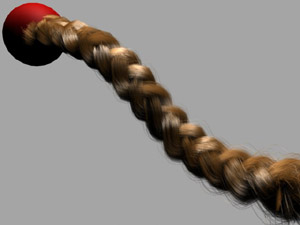BRAIDING

[ A 3-clump pigtail braid is formed from 6 guides ] One of the key ornaments that distinguish human hair are human-made patterns in hair known as braids. Braids are created for many reasons- as ornaments, to make hair stronger, to get better control of where hair ends up being, and to separate dense hair into groups. Ornatrix provides a mechanism for creating braids, located in strand sub-object mode of edit guides modifier. user is presented with options to create custom braids or choose from a list of presets. A special generator is also presented to quickly generate three different braid types with arbitrary parameters.
Every braid consists of N clumps and a stem. Clumps can be thought of clusters that form the braid, while the stem is the path along which the braid is laid out. Stem and clumps are automatically generated by averaging the shapes of selected guides. Once you have braided your hair you should separate guides in each braid clump into their own hair partings. Furthermore you may wish to add a guide-based clustering modifier to make braided hair stick close to the guides. Using wisp option with a little twist generally gives good results.
Parameters: Num clumps - Number of clumps in current braid. Current clump - The clump who's parameters are being edited. Zenith, azimuth phase, frequency - If you cut a braid through a side and look at the cross-section, you will get a plane. Assume that X axis on this plane is zenith, Y axis is azimuth, and the normal to the plane (direction of braid) is Z axis. These parameters control the sinusoidal properties of XZ and YZ dimensions of each clump. Global clumping - If there are more guides provided than clumps in current braid, this parameter controls how much these guides are attracted to their respective clumps. Note that each guide is assigned to a clump randomly. If there is same number of guides as clumps, this parameter does nothing. Global size - The azimuth/zenith dimensions of the braid. This is same as braid's radius. Azimuth scale - If you wish to scale a braid's radius non-uniformly (width not same as height), this controls the azimuth to zenith ratio. Axis rotation - Controls the twist that braid undergoes around its stem. Custom coefficient - When generating a custom braid type (not fish or pigtail), this parameter controls to sinusoid function along the zenith. Different values will generate different shapes for the braid. A value of 2 with common braids usually prevents clump overlap.
|